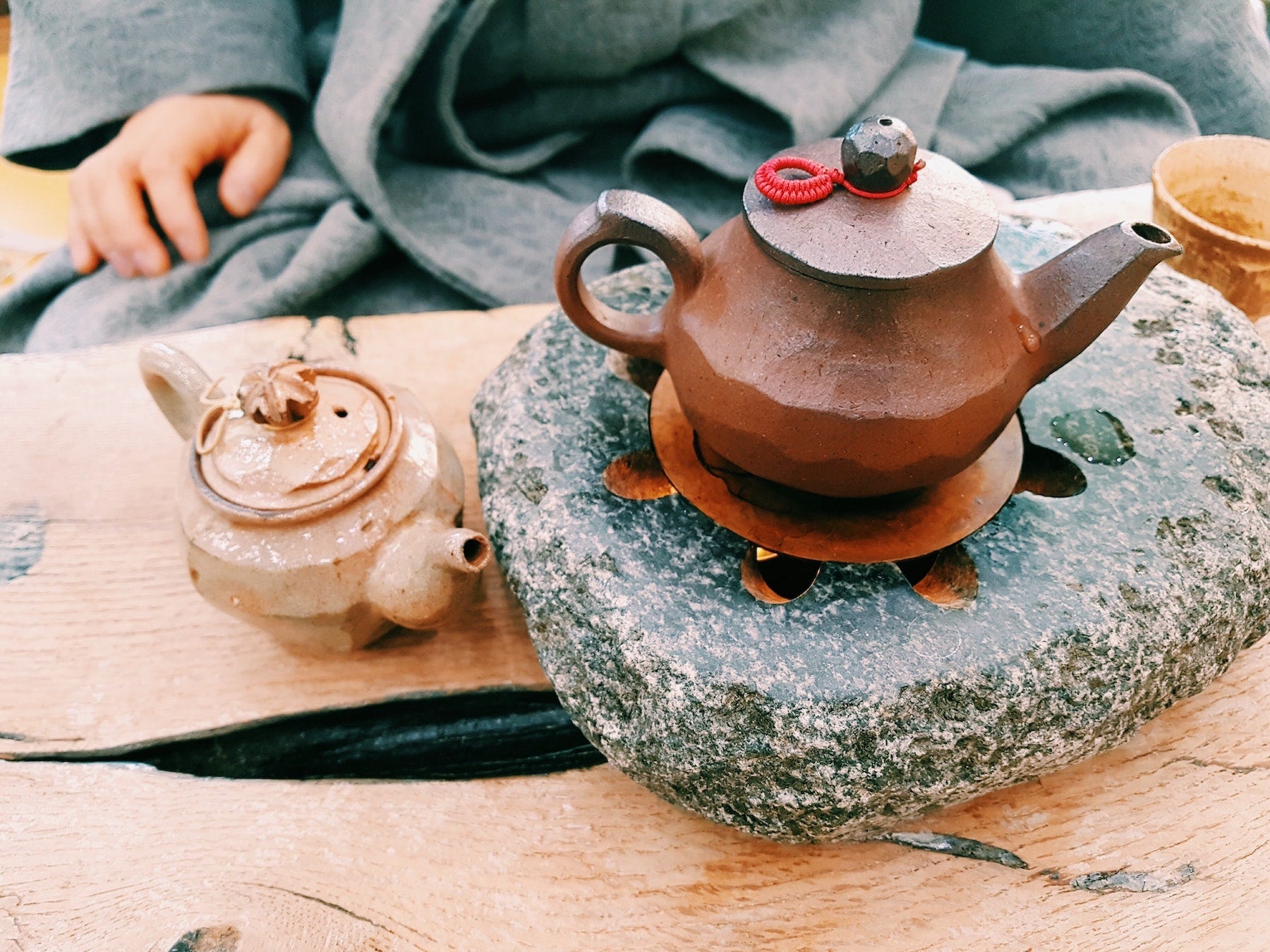The Best Teas for a Cast Iron Teapot

If you have both a cast iron teapot and an interest in drinking lots of tea, you might wonder which tea is the best to serve in your new teapot.
After all, not every tea is suitable for use in a cast iron teapot – some will react with the iron, others will leave an unpleasant aftertaste, and some won’t smell or taste quite so good!
With that in mind, we’ve put together this helpful guide to the best teas for a cast iron teapot. Each type of tea has its benefits and drawbacks when it comes to being served in a cast iron teapot, but armed with the knowledge here, you should be able to enjoy whichever type of tea most appeals to you safely.
Black and Oolong Teas
Black and oolong teas are the ideal choices for use in a cast iron teapot, as they are especially well-suited to use with cast iron pots. Like cast iron, these teas are high in iron, so they will not react with the teapot like other teas.
Because of this, black and oolong teas are extremely popular with people who want to serve tea in a cast iron teapot.
Black and oolong teas are also particularly hearty and robust, and they will not break down or lose flavor quickly when water is poured through the tea leaves in your cast iron teapot. Oolong teas are especially well-suited to use in a cast iron teapot.
Oolong teas are semi-oxidized, meaning they’ll have a more robust taste when brewed than unoxidized green teas. It makes oolong teas ideal for use in a cast iron teapot, where they will brew up rich and full-bodied.
Black teas are also ideally suited to use in a cast iron teapot. Black teas are unoxidized, so they will be rich and full when brewed in a cast iron teapot.
Green Teas
Cast iron teapots are famous in the tea community as a vessel for brewing green teas. Green teas are unoxidized, making them ideal for use in a cast iron teapot.
Green teas retain their delicate flavor, aroma, and color when brewed in a cast iron teapot. Green teas are also less hearty than black and oolong teas, meaning they are less likely to leave a flavor when brewed in a cast iron teapot.
It means that when you serve tea in a cast iron teapot, you can be sure that the taste of the tea itself comes through.
It is essential to make delicate Japanese green tea in your cast iron teapot. Green teas are not ideal for a cast iron teapot when serving guests.
Because of their delicacy, they will brew up more quickly than black teas and oolong teas. It is excellent if you want a quick cup of tea for yourself, but if you’re serving guests, you may want to use a different type of tea.
White Teas
Cast iron teapots are also ideal for brewing white teas, which are unoxidized and delicate like green teas. White teas are less hearty than black or oolong teas, making them less likely to leave a flavor in your cast iron teapot.
White teas are less likely to break down inside your cast iron teapot, so you can be sure that the taste of the tea itself comes through. White teas brew quickly, meaning you can serve them to guests without slowing down the pace of a social occasion.
White teas are an excellent choice for filling in a cast iron teapot, as they are unlikely to leave a lasting flavor in your teapot, they brew up quickly, and they are delicate and delicious.
White teas are also visually stunning, making them a great conversation starter when guests are served in your cast iron teapot.
Pu-erh Tea
Cast iron teapots are a popular choice for brewing Pu-erhs, another type of tea that is unoxidized. Pu-erhs are particularly well-suited to use in a cast iron teapot, as they will not leave a lasting flavor in your teapot that other teas may.
Pu-erhs are robust and hearty, like black and oolong teas, meaning that they will not break down or lose flavor quickly when brewed in a cast iron teapot. Pu-erhs are also incredibly rich and full-bodied, so they are ideal for serving in a cast iron teapot.
Pu-erhs are the perfect choice for filling in a cast iron teapot. They won’t leave a flavor in your teapot; they are robust, hearty, rich, and full-bodied.
Pu-erhs are also visually stunning and very unusual, making them a great conversation starter when guests are served tea in your cast iron teapot.
Herbal Teas
Cast iron teapots are also ideal for brewing herbal or infused teas, such as genmaicha, rooibos, and hibiscus. Stewed teas are brewed with other ingredients, such as herbs and spices, which will not leave a lasting flavor in your cast iron teapot.
Because of this, cast iron teapots are a popular choice for brewing stewed teas.
If you use your cast iron teapot to brew stewed teas, you can be sure that the flavor of the tea itself comes through. Stewed teas are also ideal for serving in a cast iron teapot.
They are full of flavor and aroma, meaning they will smell and taste fantastic when brewed in a cast iron teapot.
Stewed teas are an excellent choice for serving in a cast iron teapot. They are rich in flavor and aroma, meaning they will smell and taste amazing when brewed in your teapot.
FAQ
What types of tea are ideal for a cast iron teapot?
Black and oolong teas are the best choices for a cast iron teapot due to their robust nature and higher iron content.
Can I brew green tea in a cast iron teapot?
Yes, green tea can be brewed in a cast iron teapot. Its delicate flavor, aroma, and color are retained when brewed in cast iron.
What type of tea should I avoid when serving guests with a cast iron teapot?
Japanese green tea, due to its delicate nature, brews up quicker than black or oolong teas. It might not be the best choice when serving guests as it requires frequent brewing.
Are white teas suitable for cast iron teapots?
Yes, white teas are unoxidized and delicate like green teas and brew quickly, making them suitable for cast iron teapots.
How do Pu-erh teas react with cast iron teapots?
Pu-erh teas are robust and hearty. They will not break down or lose flavor quickly when brewed in a cast iron teapot.
Can I use my cast iron teapot to brew herbal teas?
Yes, herbal teas like genmaicha, rooibos, and hibiscus can be brewed in cast iron teapots, as they will not leave a lasting flavor in the teapot.
Do black teas maintain their flavor in a cast iron teapot?
Yes, black teas are hearty and robust and will not break down or lose flavor quickly when brewed in a cast iron teapot.
How do oolong teas fare in a cast iron teapot?
Oolong teas, being semi-oxidized, brew up rich and full-bodied when made in a cast iron teapot.
Why are cast iron teapots popular for brewing tea?
Cast iron teapots are visually stunning, robust, and ensure that the flavor of the tea comes through as they do not leave a lasting taste.
Which teas are quick to brew in a cast iron teapot?
White and green teas brew quickly in a cast iron teapot, making them suitable for immediate service.
Interesting Facts
Unlike other teas, black and oolong teas do not react with the cast iron teapot due to their higher iron content.
Green teas, being unoxidized, maintain their delicate flavor, aroma, and color when brewed in a cast iron teapot.
Pu-erhs, like black and oolong teas, are robust and hearty. They maintain their flavor when brewed in a cast iron teapot.
White teas and herbal teas are less likely to leave a lasting flavor in the cast iron teapot.
Stewed teas like genmaicha, rooibos, and hibiscus are full of flavor and aroma and taste fantastic when brewed in a cast iron teapot.
Related Studies
Beneficial effects of green tea: A literature review
This study focuses on the health benefits of green tea, highlighting its antioxidant, anticarcinogenic, and antimicrobial properties. Although it does not directly relate to brewing in cast iron teapots, it offers valuable insights into the benefits of green tea, which is ideal for brewing in a cast iron teapot.
Link: https://www.ncbi.nlm.nih.gov/pmc/articles/PMC2855614/
Black Tea: Chemical Analysis and Stability
This research provides a comprehensive overview of black tea's chemical composition. It underscores the robust nature of black tea and its compatibility with a variety of brewing methods, including the use of cast iron teapots.
Link: https://www.sciencedirect.com/science/article/pii/B9780123849373000061
White tea: A review on its health effects
This study elaborates on the health benefits of white tea, a type that is delicate and brews quickly in cast iron teapots.
Link: https://pubmed.ncbi.nlm.nih.gov/33458797/
Oolong Tea: A Critical Review of Processing Methods, Chemical Composition, Health Effects, and Risk
The review investigates the semi-oxidized nature of oolong tea, its processing methods, and its health benefits. It lends credence to the article's claim of oolong teas being well-suited for brewing in a cast iron teapot.
Link: https://www.mdpi.com/1420-3049/25/21/5018
Health-promoting components of different herbal teas
This study takes a closer look at the health-promoting compounds present in various herbal teas like rooibos and hibiscus, all of which can be brewed in a cast iron teapot.
Link: https://www.sciencedirect.com/science/article/pii/S2452360417300231
Conclusion
Cast iron teapots are a popular choice for serving tea, as they are visually stunning and robust enough to withstand many years of use. When brewing tea in a cast iron teapot, you can be sure that the flavor of the tea itself comes through, as the teapot will not leave a lasting taste.
Cast iron teapots are ideal for brewing black, oolong, and white and stewed teas like rooibos and genmaicha.
🍵 Savor the antioxidant-rich goodness of our Matcha Tea! Try it now for a natural energy and metabolism boost! 💚
